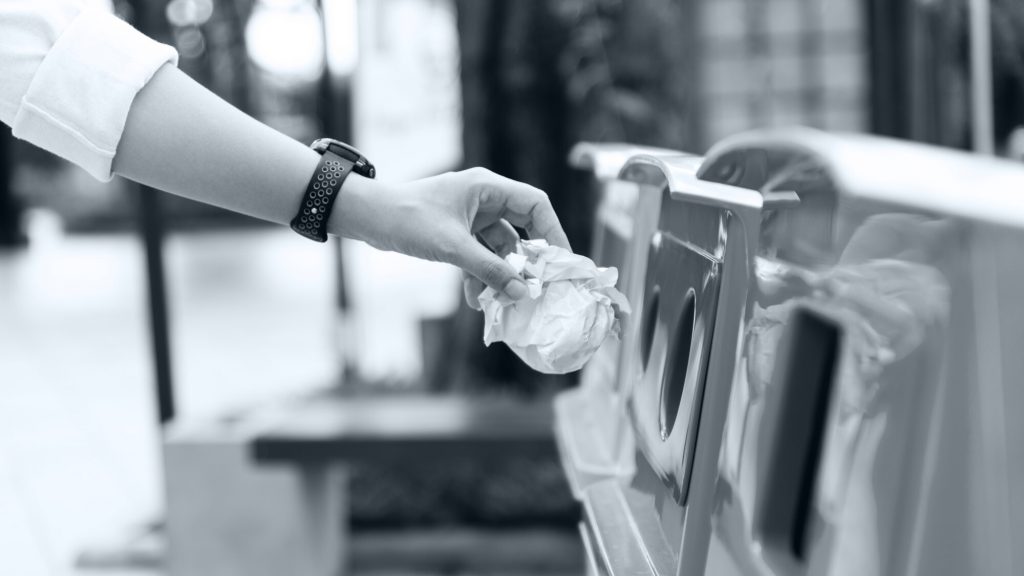Curbside recycling in the U.S. is relatively straightforward for both residents and businesses. That’s because most recycling programs in the country still adhere to a single-stream recycling system. This means that you don’t need to put individual recyclable materials (paper, plastic, glass, etc.) into separate recycling containers; instead, you merely separate the recyclable materials from the non-recyclable ones, and it is then up to a recycling facility to make sure that everything is in its right place.
Moreover, people are generally becoming more and more conscious of the way they dispose of garbage and unwanted materials these days. However, despite our best recycling efforts, we can still run the risk of recycling contamination, which can be a big problem for recycling services, businesses, individuals, and the environment. But what exactly is the issue, and what can we do to help?
What Is Recycling Contamination?
While the single-stream system is fairly simple, the recycling process as a whole is quite complicated. And one major challenge the recycling industry faces is that non-recyclable items often end up contaminating a recycling stream. The process whereby non-recyclable materials (as well as recyclable but improperly separated ones) impede the recycling system is known as recycling contamination.
Why Is Contamination in Recycling Bad?
Contamination is mostly an issue for a materials recovery facility (MRF). An MRF (known in the industry as a “murf”) is a processing and sorting facility that prepares single-stream recycling products to be sold and reused. MRFs actually deal both with recycled and non-recycled trash, often salvaging whatever materials they can from the latter. MRFs are therefore vital to the proper functioning of any city’s recycling system. However, the task of properly sorting each individual material can be grueling, and at times even impossible.
But businesses, local governments, haulers (garbage truck drivers, etc.), and individuals are also affected. That is, they can incur fines and/or other penalties if a load is rejected by a recycling facility due to contamination. When a load is rejected, it is typically sent to a landfill, which can also lead to disposal fees. Moreover, any otherwise recyclable materials are wasted. And, ultimately, recycling contamination leads to more pollution, which is not good for us or the planet as a whole.
5 Most Common Contaminants of Recycling
1 . Plastic Waste
Safely disposing of plastic and plastic materials (such as toys, cigarette butts, food wrappers, plastic bottles, bottle caps, straws, grocery bags, etc.) continues to be a major issue both in the U.S. and around the world. In fact, while mostly recyclable, plastic bags are actually the number one contaminant in the recycling industry. They often clog equipment and can even shut down an entire facility, not mention be harmful for employees. Moreover, due to contamination, only 9% of all plastics end up ever being recycled. The plastics recycling process is a complicated one, so take time to familiarize yourself on how plastic waste management works.
2. Styrofoam
Styrofoam (a type of plastic, aka polystyrene foam) can be found in anything from packing materials to toys to egg cartons to takeaway food containers to lab equipment. And styrofoam’s in a class of its own when it comes to recycling. First, due to its tiny fibers, it is not easy to properly break down. Secondly, while styrofoam is recyclable, it is difficult (and not cost-effective) for many recycling facilities and MRFs to manage. Moreover, styrofoam doesn’t decompose — if it ends up in a landfill, it stays there forever. So try to be conscious of the amount you use.
3. E-Waste
Electronic waste includes items such as discarded mobile phones, computers, TVs, electronic home appliances, lamps, toys, tools, and so on. These often contain hazardous waste (such as lead, mercury, cadmium, and arsenic) and can be very harmful to both the environment and people’s health. On the other hand, smartphones and many other e-products also contain precious rare metals — gold, copper, nickel, silver, platinum, palladium, etc. — which, if not handled properly, may also end up wasted. Meanwhile, objects like electronic wires and cables, known in the industry as “tanglers”, can seriously disrupt the machinery at a recycling facility. Fortunately, most cities in the U.S. have specialized drop-off centers where you can get rid of your used electronics safely and responsibly, so do some research before tossing that outdated smartphone in the trash.
4. Food Waste
Many perfectly recyclable materials often also end up in landfills due to food waste. This is because food residue is among the more common contaminants when it comes to recycling. Dirty napkins, wrappers, and not properly emptied jars are just a few examples of what can disrupt the recycling process at a facility. Greasy pizza boxes can be particularly troublesome, as the oil that permeates the (traditionally) cardboard box is not always easily removed during the pulping process. In other words, make sure you’ve removed that extra cheese (and/or peanut butter, etc.) to the best of your abilities.
Frozen food containers are another tricky area — while some are recyclable (that is, depending on your local recycling facility), the outer layer on others may prevent the paper from being recycled at all. So it’s always a good idea to see what the box says.
5. Compostable + Biodegradable Items
Composting and biodegradation are basically nature’s way of recycling. Therefore, both compostable items (yard waste, fruits, vegetables, and other organics) and biodegradable items (human waste, food waste, hospital waste, manure, etc.) should never go in your recycling bin. And this includes compostable and biodegradable plastics. There are industrial and/or commercial composting facilities designed to deal with such waste around the country. So do some research — but if you don’t have one in your area, just throw it in the regular trash.
How Can You Help Reduce Recycling Contamination?
According to the National Oceanic and Atmospheric Administration, 20 billion (or 3.5 million tons of) disposable diapers alone are added to landfills throughout the country each year. That’s because anything that contains human fluids is also not recyclable. And while the Environmental Protection Agency estimates that about 75% of all the waste produced in the U.S. is indeed recyclable, less than 30% actually ends up being recycled. Meanwhile, the average recycling contamination rate is 25% — that is, one in every four items. In other words, recycling is complicated.
Still, the main cause of contamination in recycling is lack of awareness. So the best way to help is to educate yourself. Reach out to your local recycling providers, familiarize yourself with the rules, and follow their guidelines. Label your trash and recycling bins accordingly. Clean your containers, separate items, and use common sense. Remember that just one contaminated item can send a whole load of perfectly recyclable materials to the landfill. So stay informed, remain diligent, and — in short — be conscious of where your stuff goes after it leaves the curbside.
To learn more about what recycling contamination is, why it matters, and how you can help, tune in to our on-demand webinar.

